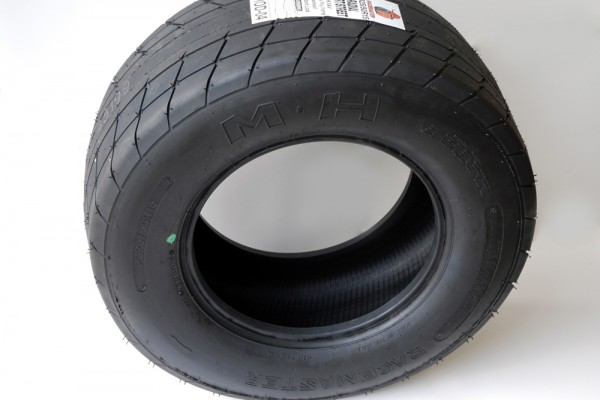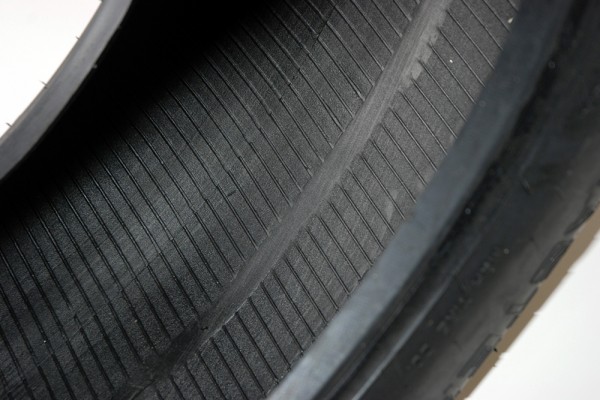Back in the early 1960s, the best tire you could get for a street/strip car was the Atlas Bucron. The Bucron was basically a retread bias-ply tire with a stickier tread compound. A fast street machine was hard pressed to break into the fifteens with a set of Bucrons, but they were the only DOT-approved tires that worked at the track (sort of).
Today, there are plenty of street-legal cars running eight-second ETs, and more than a few that have cracked the six-second zone on relatively small DOT-legal rubber. Many street car drag racing classes mandate DOT-approved tires, and some even mandate radial tires. That places a heavy burden on tire manufacturers interested in developing drag rubber that can hook up massive horsepower and meet DOT requirements for street use.
Weight and the DOT
At first glance, a drag radial tire looks like a slick with some grooves carved into it. But a DOT race tire must address factors a slick does not. One factor is vehicle weight. It’s not uncommon for an “Outlaw” P275-60 drag radial class car—one that can run sevens in the quarter-mile—to tip the scales at 3,000 pounds or more. Race-only slicks can be made as light as possible to help reduce wheel and tire mass in an effort to lower elapsed times. But building a tire to support a fast, heavy car and meet DOT highway use requirements means building a beefier tire heavier than a typical slick.
The M&H Racemaster P325-50R15 drag radial tire shown in the accompanying photos weighs approximately 25 pounds. We have seen similarly sized drag radials that tipped the scales upwards of 37 pounds. In comparison, a similarly sized conventional drag slick weighs approximately 23 pounds.
Sizing
When shopping for drag radials, compare tires based on published dimensions rather than the size shown on the sidewall. For example, our M&H Racemaster P325-50R15 tire is actually slightly smaller than the same size Mickey Thompson ET Street drag radial, except in circumference:
Dimension M&H Mickey Thompson
Tread Width 10.3 inches 11.6 inches
Section Width 12.3 inches 13.1 inches
Diameter 28.0 inches 28.0 inches
Circumference 88.0 inches 87.0 inches
Rim Size Required 11 inches 10 inches
Compounds
Tread compound is a major factor in choosing the proper drag radial. Tire manufacturers offer various compounds that range from slick-soft to harder, more street-oriented types. For example, M&H Racemaster offers five compounds (#8, HB11, #703, #704, and #20, softest to hardest). The softer the compound, the stickier the tire. But softer compounds can compromise the price of tread life, especially if you put any kind of highway mileage on them.
Mickey Thompson offers a solution to the traction/tire life problem with its ET Street drag radials. Mickey Thompson combines its relatively soft R2 compound with a proprietary sidewall design, polyester/steel belt construction, and directional tread patterns with low voids. Mickey T claims great traction and increased tire life while meeting DOT requirements.
Air Pressure
Recommending operating air pressure for drag radials isn’t easy since there are so many variables involved. Weight distribution, transmission type, chassis setup, wheel size, and other factors have an effect upon operating pressures. Many racers feel that less is better with regard to air pressure, but drag radials seem to respond better to higher pressures. Higher air pressure improves elapsed times and helps stabilize the car as it goes down the track.
Here are M&H’s recommended baseline pressures for drag strip use, based on tire diameter:
Tire Size Air Pressure
Under 30-Inch Diameter 12-16 PSI
Over 30-Inch Diameter 11-14 PSI
Mickey Thompson says its ET Street drag radials should not have less than 11 psi of air pressure for racing use. For tire sizes smaller than P275-50R15, pressure should be between 12 and 16 psi. Larger tires (P295 and up) should have air pressure set between 11 and 14 psi.
For street use, Mickey Thompson suggests you check the sidewall for maximum pressure and start at approximately 75 percent of that figure. For example, a P325-50R15 ET Street has a 35 pound maximum pressure rating, so 75 percent of that figure is 26.25 pounds.
Burnout
The type of burnout you perform is related to your tires’ compound. M&H offers this advice when using its HB11 compound drag radials:
“A hard burnout is not necessary. For the first pass of the day, make a light to moderate burnout. After that, a light burnout should suffice. Continue the burnout until the engine starts to pull down. A dry hop after the burnout isn’t recommended. For a stick shift car, perform a light burnout, haze the tires and stage immediately.”
Mickey Thompson says the tread compound used in the ET Street Radials is designed to heat quickly and does not require a heavy burnout. A dry hop after the burnout is not recommended.
Tire Life
Drag radial tires are much the same as slicks when it comes to tire life; it can vary depending on the car. According to the experts, inconsistent 60-foot and 330-foot times are caused by tread wear or carcass breakdown. That’s a signal it’s time to change tires. Disappearing tread grooves are another sign it’s time to buy new rubber (various sanctioning body rules often stipulate that some tread must remain to be legal). A good rule of thumb is to inspect your tires carefully after 30 passes. If your car is very quick, the tires should be inspected more frequently.
Keep in mind that drag radials are engineered from the ground up for racing use. They are intended for use on dry pavement only and aren’t really suitable for extended highway use. That said, modern drag radials also hook with a capital “H.” And that’s what it’s all about, isn’t it?










[…] At first glance, a drag radial tire looks like a slick with some grooves carved into it but a DOT race tire must address factors a slick does not. One factor is vehicle weight. It’s not uncommon for an “Outlaw” P275-60 drag radial class car, one that can run sevens in the quarter-mile to tip the scales at 3,000 pounds or more. Drag Radial 101 […]
Just a correction—the Atlas Bucron tire of the 60″s was NOT a recap tire. It was a new casing premium tire manufactured for the luxury car market advertising a softer ride and sold through Chevron and Standard Oil Stations.
We ran those tires on a stroker flathead Ford 49 coupe. First engine i ever built. I was 14 it was bad ass. Won modified elim first time out. the tires were 9.55 x 15 so that must have been the largest available.
Another correction (I think). I believe the tires were produced with butyl rubber made by Humble/Enco and sold thru Enco marketing. They went by the name Atlas Bucron Cheater Slicks. Atlas was the TBA (Tires/Batteries/Accessories) logo for Humble/Enco which later became Exxon which is now ExxonMobil (not that it makes any difference.
[…] CLICK THIS LINK TO READ THE FULL STORY ON DRAG RADIAL BASICS […]
[…] to know a tire dealer: Drag Radials 101: What You Need to Know About Drag Radials – OnAllCylinders Proper rear suspension with no wheel hop, 90/10 front shocks for weight transfer, your gasser […]
Ping back lead stuff link doesn’t work…..
Thanks, keep up the good work.
[…] are probably overkill, and are often disallowed from most streetcar classes. For the beginner, getting a set of DOT-approved drag radials is more common. Legal for road use, they let you fit the wheels in your garage and drive to the track, and ideally […]
[…] y, a menudo, no se permiten en la mayoría de las clases de tranvías. Para el principiante obtener un conjunto de radiales de arrastre aprobados por el DOT es más común. Legal para el uso en carretera, le permiten colocar las ruedas en su garaje y conducir hasta la […]
[…] exagérés et sont souvent interdits dans la plupart des classes de tramways. Pour le débutant, obtenir un ensemble de radiales de traînée approuvées par le DOT est plus courant. Légales pour une utilisation sur route, elles vous permettent d’installer les roues dans […]